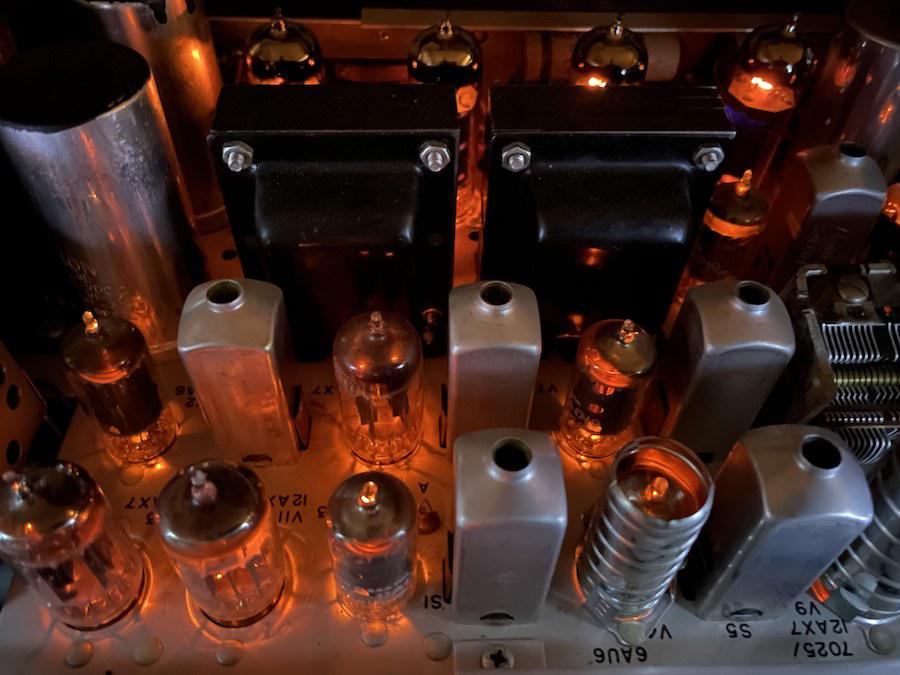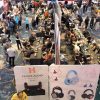Why is there still so much interest in tube amplifiers? One would think that in the digital age, the technology would be less popular but there are more than 50 companies still making high-end audio tube amplifiers. The vacuum tube as a product has existed for more than a century and consumers have listened to music through tube amplifiers longer than any other form of technology. Brands like McIntosh, Luxman, Audio Research, Conrad-Johnson, PrimaLuna, and Rogue Audio can barely keep their products in stock so there is clearly still a market for tube amplifiers. Guitar amplifiers that utilize vacuum tubes are a huge category in pro audio.
Tubes do have a sound. There is an argument to be made that modern tube amplifiers sound far closer to their solid-state counterparts than tube amplifiers that were manufactured between 1950-1980. But what exactly is that sound? Some might describe it as sounding closer to the sound of “live” music – with much higher levels of distortion. I’ve heard other people extol its virtues and say that it “takes the edge off of digital music.” Tube amplifiers definitely have a warmer sonic signature, but has that been at the expense of accuracy? After reading countless articles, I realized that it was something I needed to experience for myself.
When I started my search, I went back on Craigslist because I had so much success finding loudspeakers and receivers. I discovered a limited number that were for sale in my immediate area in Western New York, but much to my chagrin, most were priced well out of my price range. Tube amplifiers attract a lot of interest and demand for quality vintage pieces outstrips supply. Collectors who know what they are looking for jump on excellent pieces before you can even send your first email enquiry.
Sometimes you get lucky. Searching through the listings, I stumbled upon a Pilot Radio Corporation Model 602. The seller had priced it reasonably, it looked like it was in excellent condition from the photographs (Buyer Beware…this is a topic I will be getting into in another column soon) and had all of the features that I was looking for; AM/FM tuner, phono pre-amplifier, and a Tape/Aux input. Most importantly – it was a tube amplifier.
I emailed the seller and he responded with a video which gave me a more detailed look at the product. When looking for a vintage audio component like this, always ask for a video to take a closer look. I decided that I really wanted to buy it from the individual but a 4-hour driving trip in Western New York during the winter can be a challenge. I took a few days to think about it.
That proved to be a huge mistake. Sold. Apparently, I wasn’t the only person who saw the value in one of the first Pilot amplifiers I had found online. The hunt would continue.
8 Months Later…

My persistence paid off. I discovered this beautiful sample of the Pilot.
I was dead set on not losing this particular sample. It powered on, but no further testing was done by the seller. I desperately wanted this particular sample and decided that to take the risk. After insisting on a bomb-proof level of packaging, we concluded the transaction. I was admittedly nervous, but I had confidence that the unit would prove to be a smart buying decision.

Five days after it was sent out, the box arrived, and I proceeded to unbox the unit and inspect for any damage. I’m a “test and verify” person so I invested in a tube tester and 4 boxes of vacuum tubes before the unit even arrived. If we’re going to grow this hobby, we need to get the next generation involved; I invited my nine year-old son to help me with tube testing (safety first) and we removed all of the tubes, documented where they were placed, and began our tube testing experiment. We went through the “decoder” manual together and created a list of settings for each of the tubes that we were going to test. The calibration process was not overly difficult, and it was an excellent hands-on way to learn how to properly do this.

4 of the tubes tested poorly and had to be replaced.
Google can be an excellent way to find replacement tubes, but it can also be a source of frustration. There are some reputable online resellers of new and NOS (New Old Stock) vacuum tubes, but the prices vary from one store to the next and you really need to read the customer comments before you make a purchase.
I found a matched set of 4 Mullard reissue EL84 output tubes and a matched pair of Electro-Harmonix 12AX7 input tubes that were not unreasonable.
Power Off and Time to Clean
While we waited for the tubes to arrive, we began cleaning the unit. I found it necessary to clean all of the pots, and input jacks with Deoxit. Removing the dirt and grim was accomplished slowly with a water and dish soap mixture applied with Q-tips and a lot of patience. I hope I don’t need to remind people of this, but never clean any piece of equipment when it is plugged in. The remaining tubes were cleaned with dry cotton balls. Why dry cotton balls? I tested cleaning one of the broken tubes and the emblem and writing washed right off with liquid. Cleaning the glass was also done with dry cotton balls and performed very slowly. The two dead bulbs were swapped with “warm white” LEDs which I’m not a fan of but for this unit they fit aesthetically.


With everything cleaned, lubricated, tested, and the tubes reset in their sockets, we were ready to turn the Pilot back on and listen to music.
I decided to use the Pilot with a pair of Ohm E loudspeakers and an Echo Dot as the source device (I’m not a purist and love the ease of hearing whatever song I want just by barking it out to “Alexa”).

I fired her up.
Nothing. The silence was a good thing as the tubes began to warm up.
This was only the second time the Pilot 602 had been powered up during the entire process and it was a tad scary and exciting at the same time. If you are powering up any piece of equipment of unknown condition, it is always best to use a Variac or to have a technician inspect it beforehand.
Once I was certain that the Pilot 602 was stable, I called out “Alexa plays Peter Gabriel” and the testing began.
As I cleaned up the workbench, I shuffled songs from a playlist and smiled as the music filled the basement. The Pilot 602 is a great little receiver that I have been using now for over a year. The only change that I have made was to have a new case fabricated by a neighbor so that I could showcase the tubes and improve the ventilation around the unit.
How Does it Sound?
As I’ve discovered with some vintage components, not every piece is a home run.
The Pilot 602 has proven to be a surprising performer within its limitations.
While not as powerful as the Fisher 400 receiver, it can be just as enjoyable with the right loudspeakers. It uses EL84 output tubes and is rated between 12-15 watts/channel into 8 ohms. Not exactly a powerhouse of a receiver and I would suggest pairing it with loudspeakers that are 90 dB+ and it performs better in a smaller room or office.
Loudspeaker options that have worked for me so far include Klipsch KG 5.5, KG 4, Ohm E, and the EPI M100 – all solid budget loudspeaker choices for the Pilot 602.
I can see it working with the Klipsch RP-600M or Omega Speaker Systems Super 7 Monitor MK 2 which are both high-sensitivity bookshelf loudspeakers and in need of some added midrange warmth.
Having compared this to the Fisher 400 and H.H. Scott 222, the Pilot 602 can hold its own considering the price differences between the amplifiers.
The Bad
The Pilot 602 has some shortcomings. It is very rare to find one in mint condition, so prepare to spend time and money cleaning it up. A little bit of patina should be expected. You may also have to replace some of the capacitors depending on their condition. It is also not a very powerful amplifier. The phono stage needs a high output MM cartridge and has a lot less gain than the tape input (where you should connect a CD player, DAC, or streamer).
There are two other variants called the Pilot 602m and 602sa to search for, but my understanding is that both were generally used inside consoles. Console pull models are a little easier to find but will need a case to be fabricated to hold the faceplate in place. The 602 is a great value in entry-level vintage tube receivers and depending on location, can be found in the $250-500 range depending on condition and service history.











































Joe Pop
February 11, 2021 at 1:33 pm
Nice write up. I love the idea of vintage, but haven’t taken the leap. Partly because of the escalating prices. Us stinking boomers are heavy into nostalgia. I am looking for a vintage set of speakers (late 70s era) to pair with my 1987 Yamaha Receiver that I purchased new, and some of the prices I am seeing are way beyond what I would be willing to spend for 40 something year old speakers. So I am looking for an underappreciated brand that may be affordable. Must be patient, as you were in your search.
Followed your Instagram.
Peace
Joe Pop
Deb
February 13, 2021 at 2:25 am
Very detailed and interesting article. 👍
Marc Goldin
April 7, 2021 at 7:16 pm
I actually had a 602 myself. My Dad gifted it to back in the ’70’s. It my front end during my college years. I had paired with some Genesis Physics Corp 110 floor standing speakers (89 db efficient), and a BIC 980 turntable. To make a long story short, it sounded fantastic! It could drive those Genesis and their 10 inch woofers at consert volume without any distortion.
Sal Torres
August 30, 2021 at 12:57 pm
Hello,
I picked up one these and am looking to upgrade some tubes, mainly the output and the 2 input ones. My question is which ones are considered the input tubes(pre-amp)?
BRIAN
April 14, 2022 at 11:13 pm
My Pilot 402 helped me to understand the term “musical”. Very clean sound with great spatial cues. I’m an SE guy, but I’ve read reviews of Pilots from vintage guys who have experienced Fisher, Scott and Marantz and surprisingly there are some who say Pilot is the best.
Jeffrey Eggleston
July 30, 2023 at 7:25 am
I have Eico, Knight, Thordarson, Monoprice & Aosobi models. But I am on the trail of this Pilot model. There is brown scortch marks around the fuse cap so I know I’m in for heavy hours at the bench. But, I love gear-all kinds. My best combo is the Dyna ST70/pas3x. Beastly beautiful. If I score the Pilot I will check back. I use Cornwalls and Heresy with my tubes. Also, Bozak’s. Vintage was made to use with contemporary equipment. Simple, but safe rule of thumb.
✌️Jeffro
Michael Scott Cutler
August 20, 2023 at 2:30 pm
I just bought a 1960, Pilot 654 AM/FM Tuner-Amplifier for $250.00 on Facebook Marketplace. I believe the main difference between the 654 and the 602 is that the former is 60 watts and the 602 is 30 watts. They look identical, though.